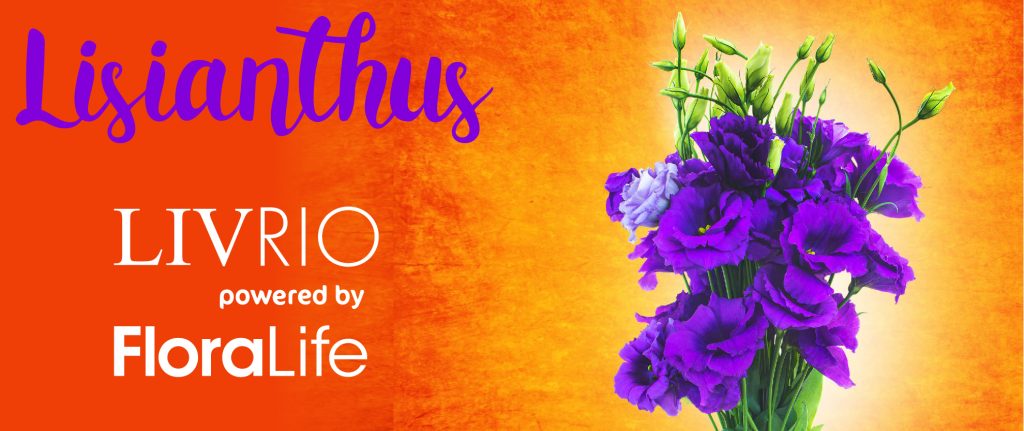Lisianthus: A Surprisingly Perfect Halloween Addition.
LivRio Magazine September 2021, powered by FloraLife

As the days in the northern hemisphere begin to grow shorter, and the temperatures cool ushering in the arrival of Autumn, we turn our thoughts to all things fall. Cozy sweaters, afternoon walks through turning trees, and Halloween.
Halloween, or All Hallows Eve as it was known, marked the end of summer and the beginning of winter. Today this date is celebrated in many different ways, including with flowers. The traditional colors of Halloween are black and orange, but rest assured, your floral arrangements don’t have to stick to this color scheme. Whether you’re creating a ghostly white design, a vampy red and pink bouquet, or looking to add a bit of purple drama to a gothic arrangement, Lisianthus will fit the bill perfectly.
Available in many shades including purple, pink, white and red, Lisianthus flowers may look delicate, but they will surprise you by how long lasting they are. Treat them right, and they will match the longevity of chrysanthemums, making them the perfect companions in a classic fall bouquet.
Lisianthus Care and Handling Tips
Purchasing
- Choose stems with 1 – 3 flowers open.
- Avoid any stems with leaf yellowing.
Shipping and Storage
- Shipping and storage temperatures should be 34 – 38° F / 1 – 3° C.
- Stems should be shipped and stored wet if possible.
Re-hydration At Store Level and Storage
- Start processing with a clean bucket, sanitized with FloraLife® D.C.D.® Cleaner.
- Remove any leaves that are below the flower food solution.
- If received dry packed, conditioning of stem ends is recommended to prevent blockage and promote uptake. Cut approximately 1” / 3cm or more off stems. Use clean, sanitized clippers or knife, and treat with FloraLife® Quick Dip.
- Immediately place flowers in properly dosed solutions (Flower Food and water) containing either FloraLife Chrystal Clear® or Floralife® Express 300. Do not put flowers directly in metal/galvanized buckets. Use clean, high quality water that has not been treated with a water softener as the salt levels can be damaging to flowers.
- Store in a cooler at 34 – 38° F / 1 – 3° C with a relative humidity of 75-85%
- Allow minimum 2 hours to hydrate placing buckets in an area with good airflow.
- Always remember FIFO (first in/first out) when rotating flowers.
Vase Care
- Remove any leaves that might be below the vase solution.
- If received dry, cut approximately 1” or more off stems. Use clean, sanitized clippers or knife, and treat with FloraLife® Quick Dip.
- Immediately place flowers in properly dosed vase solutions (Flower Food and water) containing FloraLife Chrystal Clear® (the perfect solution for clear vases), or FloraLife® Express 300 (the no cut premium solution).
Common Defects:
- Botrytis can develop on leaves if stems are packed together too tightly. Always allow enough space for air to flow around the stems.
- Stem bending – flowers are geotropic and should be shipped and stored upright in bucket solutions.
- Flowers not opening.
- Foliage yellowing.
Special Considerations:
- Some varieties can be ethylene sensitive, leading to poor opening, premature wilting, and leaf yellowing. Treating with an ethylene action inhibitor treatment such as EthylBloc™ or FloraLife® EthylGuard can help these varieties.
- Other causes for poor opening can be product age (stored too long) or storing dry for long periods.
- Color fade on blooms can be due to improper use of flower food or exposure to intense light sources.
- Studies show the benefits of storage in solutions containing higher sugar levels – for this reason, wholesalers and retailers might consider storing flowers in FloraLife Crystal Clear® or FloraLife® Express 300 or even FloraLife® Flower Food 300.
- Studies report that wet storage improves vase life and bud development.
To learn about best practices from the experts in flower care or to inquire about products and availability in your region, visit www.floralife.com or contact your local FloraLife representative.
*Product availability depends upon geographical region.
